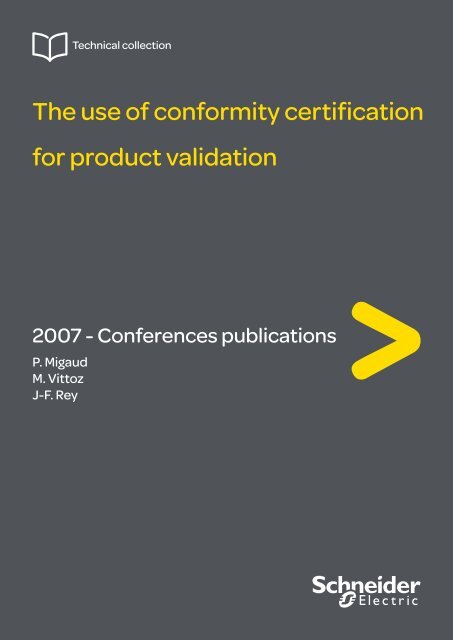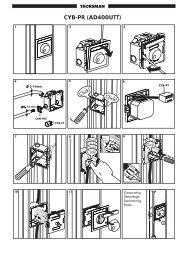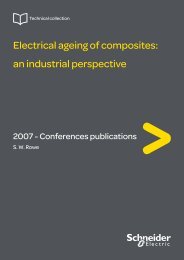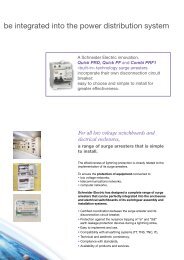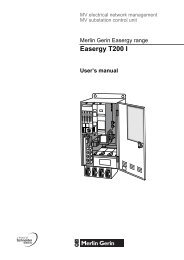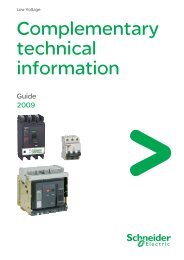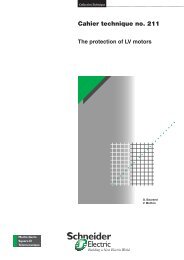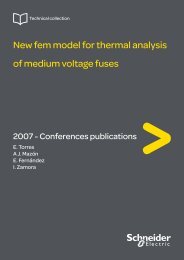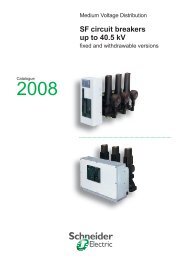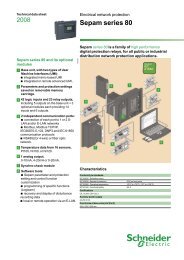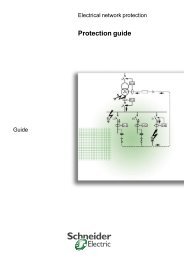The use of conformity certification for product ... - Schneider Electric
The use of conformity certification for product ... - Schneider Electric
The use of conformity certification for product ... - Schneider Electric
Create successful ePaper yourself
Turn your PDF publications into a flip-book with our unique Google optimized e-Paper software.
Technical collection<br />
<strong>The</strong> <strong>use</strong> <strong>of</strong> <strong>con<strong>for</strong>mity</strong> <strong>certification</strong><br />
<strong>for</strong> <strong>product</strong> validation<br />
2007 - Conferences publications<br />
P. Migaud<br />
M. Vittoz<br />
J-F. Rey
<strong>Schneider</strong> <strong>Electric</strong> 2007 - Conferences publications<br />
THE USE OF CONFORMITY CERTIFICATION FOR PRODUCT<br />
VALIDATION<br />
Pierre MIGAUD, EDF R&D, (France), Pierre.migaud@edf.fr<br />
Marc VITTOZ, AREVA T&D, (France), marc.vittoz@areva-td.com<br />
J.-F. REY, SCHNEIDER ELECTRIC, (France), jean-francois.rey@schneider-electric.com<br />
ABSTRACT<br />
For MV and HV switchgear, Utilities (and generally speaking<br />
Users) most <strong>of</strong>ten request a reliable demonstration <strong>of</strong> safety<br />
and per<strong>for</strong>mances. <strong>The</strong> purpose <strong>of</strong> this paper is to describe<br />
a way to adapt the concept <strong>of</strong> Product Certification to<br />
electrical equipment <strong>for</strong> Transmission and Distribution<br />
networks.<br />
<strong>The</strong> main features <strong>of</strong> this <strong>certification</strong> scheme are :<br />
o Independence based on the strong involvement <strong>of</strong> each<br />
party : Manufacturers, End Users, Testing Laboratories<br />
and independent experts,<br />
o Competence based on Testing Laboratories,<br />
o Certification scope limited to the <strong>con<strong>for</strong>mity</strong> <strong>of</strong> the type <strong>of</strong><br />
<strong>product</strong>,<br />
o International recognition through accreditation.<br />
<strong>The</strong> main advantages <strong>of</strong> this system are :<br />
o <strong>The</strong> organisation is cost effective,<br />
o <strong>The</strong> organisation is time effective and flexible,<br />
o Responsibilities are clearly split between the<br />
stakeholders,<br />
o Certificates are well accepted.<br />
KEYWORDS<br />
Con<strong>for</strong>mity Assessment, Testing, Laboratory, Certification,<br />
Accreditation.<br />
INTRODUCTION<br />
Testing is only part <strong>of</strong> <strong>con<strong>for</strong>mity</strong> assessment<br />
Assessing the <strong>con<strong>for</strong>mity</strong> <strong>of</strong> a <strong>product</strong> is part <strong>of</strong> the<br />
relationship between the Manufacturer and the possible<br />
Users <strong>of</strong> a <strong>product</strong>. For Medium Voltage and High Voltage<br />
electrical equipment, assessment is based on the results <strong>of</strong><br />
tests in most cases. However, it is not only the result <strong>of</strong> a<br />
single type test that allows to decide that a <strong>product</strong> fulfils all<br />
the requirements <strong>of</strong> a specification.<br />
Tens <strong>of</strong> type tests have to be per<strong>for</strong>med, addressing various<br />
sharp technical competences. Several samples <strong>of</strong><br />
equipment may be required to per<strong>for</strong>m the complete list <strong>of</strong><br />
type tests. And when a range <strong>of</strong> <strong>product</strong>s is concerned, it is<br />
<strong>of</strong>ten cost effective to combine different tests with various<br />
options <strong>of</strong> equipment in order to cover the whole range <strong>of</strong><br />
rated values with the minimum set <strong>of</strong> tests.<br />
Some tests may fail (it is part <strong>of</strong> the game, otherwise testing<br />
would be <strong>use</strong>less), leading to adjustments or improvements<br />
<strong>of</strong> the <strong>product</strong> design. In such a case it is important to avoid<br />
repeating the whole test series if possible, in order to<br />
minimize costs and delays. <strong>The</strong>n technical competences<br />
are needed to decide which tests have to be repeated<br />
according to the necessary design adjustments.<br />
Last but not least, identification <strong>of</strong> the <strong>product</strong> (or range <strong>of</strong><br />
<strong>product</strong>s) is part <strong>of</strong> the <strong>con<strong>for</strong>mity</strong> assessment. This is not<br />
the less complicated task if the design has been updated in<br />
the course <strong>of</strong> the testing process.<br />
Consequently, assessing the <strong>con<strong>for</strong>mity</strong> <strong>of</strong> a piece <strong>of</strong><br />
equipment is not only per<strong>for</strong>ming type tests, but also<br />
defining the list <strong>of</strong> tests to be per<strong>for</strong>med (or repeated),<br />
interpreting test results with regards to the test conditions,<br />
checking that drawings adequately represent the objects<br />
under tests. <strong>The</strong> complexity <strong>of</strong> this activity is well described<br />
by ISO/IEC Guide 67 (see table 1 in [1]). For the sake <strong>of</strong><br />
simplicity, we can split this bunch <strong>of</strong> tasks in two parts :<br />
per<strong>for</strong>ming tests on one hand, and making a decision about<br />
<strong>con<strong>for</strong>mity</strong> on the other hand.<br />
<strong>The</strong>re are many ways to split the<br />
responsibilities<br />
As far as Testing is concerned, tests may be per<strong>for</strong>med in<br />
the Laboratories <strong>of</strong> the Manufacturer (called First Party) or<br />
in the Laboratories <strong>of</strong> the User (called Second Party),<br />
assuming such facilities are available. <strong>The</strong>y are also <strong>of</strong>ten<br />
per<strong>for</strong>med by commercial Laboratories which are belonging<br />
neither to the Manufacturer nor to the User (called Third<br />
Party Laboratories).<br />
As far as the decision is concerned, various situations may<br />
be encountered :<br />
o <strong>The</strong> Manufacturer may supervise the testing process<br />
himself and finally attests the <strong>con<strong>for</strong>mity</strong> <strong>of</strong> the object<br />
This is First Party assessment.<br />
o Some Utilities may demand to be involved in the<br />
assessment process (witnessing tests, reviewing the test<br />
results, attending the final expertise <strong>of</strong> the object after<br />
tests, and so on…). A given Utility may also rely on an<br />
external consultant <strong>of</strong> his choice, or an assessment<br />
panel made <strong>of</strong> several Utilities interested in the same<br />
pieces <strong>of</strong> equipment. Those two cases are Second Party<br />
assessment.<br />
o Third Party Bodies may also <strong>of</strong>fer services such as<br />
supervising tests and reviewing test results. Amongst<br />
these bodies, we may find Certification Bodies or<br />
Inspection Bodies, as well as equivalent or alike bodies.<br />
Some <strong>of</strong> these bodies may operate their own testing<br />
facilities, while others may resort to separate<br />
Laboratories to have tests per<strong>for</strong>med (either Third Party<br />
Laboratories, or Firsts or Second Party Laboratories in<br />
some cases).
<strong>Schneider</strong> <strong>Electric</strong> 2007 - Conferences publications<br />
Moreover, any combination <strong>of</strong> these various means <strong>of</strong><br />
assessment is also possible. <strong>The</strong>re is no right or wrong<br />
recipe. All is a matter <strong>of</strong> equilibrium between parameters<br />
such as : the financial amount at stake (price per unit X<br />
number <strong>of</strong> pieces), the possible impact <strong>of</strong> the piece <strong>of</strong><br />
equipment on the reliability <strong>of</strong> the network, the availability <strong>of</strong><br />
testing facilities, the availability <strong>of</strong> human resources and<br />
competences <strong>of</strong> each Party, the sale strategy <strong>of</strong> the<br />
Manufacturer, the purchase strategy <strong>of</strong> the Utility, and so<br />
on…<br />
To the end, the responsibility always lies on the shoulders<br />
<strong>of</strong> the Manufacturer who guarantees the rated<br />
per<strong>for</strong>mances, and on the shoulders <strong>of</strong> the Utility who<br />
intends to operate the equipment on its network <strong>for</strong> tens <strong>of</strong><br />
years hopefully. This is why it is <strong>of</strong>ten important <strong>for</strong> them to<br />
keep an eye on the assessment process, being able to<br />
make sure the Laboratories in charge <strong>of</strong> testing and the<br />
Body in charge <strong>of</strong> deciding are correctly fitted to the<br />
interests at stake.<br />
An example <strong>of</strong> assessment system dedicated<br />
to MV and HV <strong>product</strong>s<br />
<strong>The</strong> purpose <strong>of</strong> this paper is to describe an original solution<br />
<strong>for</strong> <strong>con<strong>for</strong>mity</strong> assessment, based on the general concepts<br />
<strong>of</strong> <strong>certification</strong> and accreditation, involving each Party, and<br />
tuned to fit the specific requirements <strong>of</strong> MV and HV<br />
equipment. Such a solution that has been implemented in<br />
France <strong>for</strong> ten years, may be chosen each time a Third<br />
Party assessment is required.<br />
FEW RECALLS ABOUT GENERAL CONCEPTS<br />
<strong>The</strong> concept <strong>of</strong> Product Certification has been first<br />
developed <strong>for</strong> mass <strong>product</strong>s in order to remove technical<br />
trade barriers. Accreditation is also intended on the same<br />
purpose since it is a way to get international recognition.<br />
<strong>The</strong> basis <strong>of</strong> both concepts is briefly recalled hereunder.<br />
Product Certification<br />
Product Certification is described by EN 45011 [2] that is<br />
identical to ISO/IEC Guide 65 [3]. It is a broad concept that<br />
encompasses all kinds <strong>of</strong> “<strong>product</strong>s” (including processes<br />
and services) and may be implemented in different ways,<br />
including or not including : initial testing, assessment <strong>of</strong> the<br />
suppliers’ quality systems, surveillance <strong>of</strong> the factory quality<br />
system, subsequent surveillance testing <strong>of</strong> samples from<br />
the factory, and son on… (see Introduction in [2] or [3]).<br />
It is important to keep in mind that the concept <strong>of</strong> Product<br />
Certification ranges from <strong>certification</strong> systems based on<br />
type testing, to <strong>certification</strong> systems including type testing<br />
and surveillance <strong>of</strong> the manufacturing process. <strong>The</strong> choice<br />
<strong>of</strong> a given system within this range depends <strong>of</strong> <strong>product</strong><br />
specificities and market needs.<br />
It is important also to note that the scope <strong>of</strong> the standards<br />
[2] and [3] is so broad that each Certification Body is<br />
responsible to adapt the general requirements <strong>of</strong> the<br />
standard to its specific domain <strong>of</strong> activity.<br />
But in any case, all <strong>certification</strong> systems exhibit a common<br />
feature that is to be operated by Third Party Bodies (being<br />
both independent from the Manufacturer and from the<br />
User).<br />
<strong>The</strong> outcome <strong>of</strong> a Product Certification system is usually<br />
called a “certificate <strong>of</strong> <strong>con<strong>for</strong>mity</strong>”. It is important to avoid<br />
confusion with look alike wordings that may be <strong>use</strong>d <strong>for</strong><br />
designation <strong>of</strong> documents that do not result from a Product<br />
Certification system.<br />
Accreditation<br />
According to the International Vocabulary [4], Accreditation<br />
is a “third-party attestation related to a <strong>con<strong>for</strong>mity</strong><br />
assessment body conveying <strong>for</strong>mal demonstration <strong>of</strong> its<br />
competence to carry out specific <strong>con<strong>for</strong>mity</strong> assessment<br />
tasks”. It is described by EN ISO/CEI 17011 [5].<br />
According to European Regulation, Accreditation is a non<br />
pr<strong>of</strong>it activity that is “operated in each Member State by a<br />
single national accreditation body” (see article 4 in [6]).<br />
Following these principles :<br />
o a Laboratory that complies with ISO/IEC 17025 [7] may<br />
be accredited according to this standard by an<br />
Accreditation Body,<br />
o a Certification Body that complies with EN 45011 [2] may<br />
be accredited according to this standard by an<br />
Accreditation Body.<br />
In both cases, it is important to note the difference between<br />
“complying with…” and “being accredited according to…”<br />
that means “providing an evidence <strong>of</strong> compliance with…”.<br />
Only Accreditation provides a <strong>for</strong>mal evidence <strong>of</strong><br />
compliance.<br />
It is to be noted that Quality Requirements <strong>of</strong> ISO<br />
9001:2000 are fully covered by ISO/IEC 17025:2005, as<br />
stated in [8] : “<strong>The</strong> management system requirements in<br />
ISO/IEC 17025 (Section 4) […] meet the principles <strong>of</strong> ISO<br />
9001:2000 Quality Management systems – Requirements<br />
and are aligned with its pertinent requirements”. As a<br />
consequence a Laboratory has no need <strong>for</strong> ISO 9001<br />
<strong>certification</strong> if it is already accredited against ISO/IEC<br />
17025.<br />
On the contrary, it is important to mention that ISO/IEC<br />
17025 goes further than ISO 9001, with additional<br />
requirements <strong>for</strong> technical competence and metrology that<br />
are specific to Laboratories.<br />
SPECIFIC FEATURES OF MV/HV EQUIPMENT<br />
<strong>The</strong> assessment schemes that have been tailored <strong>for</strong> mass<br />
domestic <strong>product</strong>s may not fit MV and HV network<br />
equipment that have specific features. Amongst these<br />
specific features, let us consider the main ones as follows :<br />
o <strong>The</strong> ratio between the cost <strong>for</strong> testing (including the cost<br />
<strong>of</strong> the object under tests) and the number <strong>of</strong><br />
manufactured <strong>product</strong>s may be much higher <strong>for</strong> network<br />
equipment than <strong>for</strong> domestic <strong>product</strong>s. As a<br />
consequence, it is more <strong>of</strong> all important to avoid <strong>use</strong>less<br />
test repetitions.
<strong>Schneider</strong> <strong>Electric</strong> 2007 - Conferences publications<br />
o Due to the investment amount requested <strong>for</strong> testing<br />
facilities (especially facilities <strong>for</strong> power testing), few Third<br />
Party Laboratories are available over the world. Apart<br />
from the few Third Party Laboratories, the competence is<br />
mostly available in the Manufacturers and the Utilities. As<br />
a matter <strong>of</strong> fact, it is the case in France <strong>for</strong> instance, as<br />
far as HV switchgear is concerned.<br />
o Utilities are very much involved in the technical<br />
assessment <strong>of</strong> the <strong>product</strong>s <strong>for</strong> two reasons. First, some<br />
pieces <strong>of</strong> equipment may have a strategic impact on the<br />
energy network. Second, purchasing equipment is a long<br />
term investment over at least 30 years and sometimes<br />
more.<br />
o Manufacturers <strong>of</strong> MV and HV equipment need to keep<br />
control on their development and assessment process<br />
and not depend on the availability <strong>of</strong> external<br />
Laboratories.<br />
A CERTIFICATION SYSTEM TAILORED FOR<br />
MV AND HV EQUIPMENT<br />
It is possible to design a <strong>certification</strong> system that takes<br />
advantages <strong>of</strong> the general concepts as described above<br />
(<strong>certification</strong> and accreditation) and that is tuned up to suit<br />
the specific features <strong>of</strong> MV and HV electrical equipment.<br />
For instance, such a solution has been implemented in<br />
France <strong>for</strong> years in the shape <strong>of</strong> a unique combination <strong>of</strong><br />
partners, concepts, principles, and rules <strong>of</strong> operation. <strong>The</strong><br />
legal frame <strong>of</strong> the French Certification Body that comes out<br />
<strong>of</strong> this combination is a non pr<strong>of</strong>it association involving<br />
Manufacturers, Utilities and Third Party stakeholders<br />
(Laboratories and Standardization Body).<br />
Let’s have a look at the main characteristics <strong>of</strong> the French<br />
Certification Body :<br />
Independence, impartiality and involvement<br />
o Independence <strong>of</strong> the French Certification Body is<br />
guaranteed by its constitution that grants a balanced<br />
influence to each Party. In this case, independence<br />
doesn’t mean this Body is operated on commercial<br />
purpose only and doesn’t care about the possible<br />
outcome <strong>of</strong> the <strong>certification</strong>s it per<strong>for</strong>ms. On the contrary,<br />
Manufacturer and Utility members <strong>of</strong> the French<br />
Certification Body, are very much concerned by the<br />
results <strong>of</strong> the <strong>certification</strong> if they manufacture the object<br />
under test, or if they intend to operate it <strong>for</strong> 30 years on<br />
their network. This involvement is the guarantee that<br />
each object under <strong>certification</strong> is thoroughly tested and<br />
that results are deeply examined. Nevertheless the<br />
equilibrium between the different Parties leads to a final<br />
decision that is impartial in any case. Thus, involvement<br />
and impartiality are the ground <strong>for</strong> independence.<br />
o From a practical point <strong>of</strong> view, it should be noted that the<br />
“Three Party System” exists at each level <strong>of</strong> this Body,<br />
and not only on the top <strong>of</strong> the pyramid. From the<br />
Technical Committee up to the Board <strong>of</strong> Directors, each<br />
part <strong>of</strong> the French Certification Body has a balanced<br />
management. Especially the Certification Committee is<br />
composed <strong>of</strong> the three Parties : it is in charge <strong>of</strong> granting<br />
or refusing certificates based on technical evaluation <strong>of</strong><br />
test results.<br />
o <strong>The</strong>re is a close relationship between this Body and the<br />
Laboratories where the tests are per<strong>for</strong>med. This<br />
relationship is called homologation. <strong>The</strong> French<br />
Certification Body is responsible <strong>for</strong> granting<br />
homologation to a Laboratory <strong>for</strong> a limited period <strong>of</strong> time.<br />
Periodical reviews are made to keep up homologation.<br />
Accreditation according to ISO/IEC 17025 is one <strong>of</strong> the<br />
requirements <strong>for</strong> homologation. Other requirements are<br />
related to technical competence (<strong>for</strong> a given nature <strong>of</strong><br />
tests, on a given category <strong>of</strong> <strong>product</strong>s), and rules <strong>of</strong><br />
operation that place the testing process under the control<br />
<strong>of</strong> the French Certification Body.<br />
o Homologated Laboratories may be Manufacturer’s<br />
Laboratories or Utility’s ones. But in any case, tests are<br />
supervised by the French Certification Body. Supervision<br />
includes test program, test planning, witnessing,<br />
identification <strong>of</strong> the objects under tests, and test reports.<br />
Technical observers are selected and appointed by the<br />
French Certification Body.<br />
Technical competence<br />
o Competence <strong>of</strong> the French Certification Body is made <strong>of</strong><br />
the competence <strong>of</strong> the members <strong>for</strong>ming the Body. And<br />
the core <strong>of</strong> the competence is located in their<br />
Laboratories. This is the reason why technical experts<br />
acting as observers and reviewers are chosen amongst<br />
the teams <strong>of</strong> experienced test engineers <strong>of</strong> the<br />
homologated Laboratories. This brings the guarantee<br />
that competence <strong>of</strong> observers and reviewers is kept up to<br />
date thanks to their everyday pr<strong>of</strong>essional activity.<br />
o Observers never come from the laboratory which is<br />
per<strong>for</strong>ming the test. Observers always belong to a<br />
separate Company.<br />
Scope <strong>of</strong> activity in line with the needs <strong>of</strong> the<br />
market<br />
o <strong>The</strong> Product Certification System operated in France is<br />
limited to the <strong>con<strong>for</strong>mity</strong> <strong>of</strong> the type <strong>of</strong> <strong>product</strong>. It<br />
corresponds to the column 1 in table 1 <strong>of</strong> ref [1]. It does<br />
not include Surveillance. <strong>The</strong> reason <strong>for</strong> it is that MV and<br />
HV are produced in small series (compared to domestic<br />
mass <strong>product</strong>s). Most Utilities operates themselves their<br />
own schemes <strong>for</strong> Surveillance, taking into account their<br />
return <strong>of</strong> experience.<br />
o <strong>The</strong> scope <strong>of</strong> activity <strong>of</strong> the Body is not limited to IEC<br />
standards. It includes also national standards and<br />
specifications, not only French ones, but also German<br />
ones or Italian ones <strong>for</strong> instance. It is a matter <strong>of</strong> fact that<br />
large Utilities throughout Europe have their own<br />
specification. So there is no reason to limit the scope <strong>of</strong><br />
activity to IEC.<br />
o It is possible to issue a partial certificate covering only a<br />
part <strong>of</strong> the requirements <strong>of</strong> a standard as far as the batch<br />
<strong>of</strong> tests per<strong>for</strong>med is consistent to demonstrate a given<br />
per<strong>for</strong>mance (dielectric per<strong>for</strong>mance <strong>for</strong> instance). In
<strong>Schneider</strong> <strong>Electric</strong> 2007 - Conferences publications<br />
such a case, the scope <strong>of</strong> the <strong>certification</strong> is clearly<br />
mentioned on the front page <strong>of</strong> the certificate. Once<br />
again, this answers to a requirement <strong>of</strong> the market since<br />
Utilities are not always interested in getting the same<br />
level <strong>of</strong> guarantee <strong>for</strong> the whole batch <strong>of</strong> tests <strong>of</strong> a<br />
standard. Utilities may accept mere tests reports <strong>for</strong><br />
some tests, and focus their attention on the tests that are<br />
the most strategic <strong>for</strong> them according to their application.<br />
Recognition<br />
<strong>The</strong> competence and independence <strong>of</strong> the French<br />
Certification Body is recognized through its accreditation by<br />
COFRAC (the French Accreditation Body) according to EN<br />
45011 [2], [3]. It is a voluntary choice <strong>of</strong> the French<br />
Certification Body to go through the accreditation process to<br />
demonstrate its transparency and competence, and to enter<br />
into a continuous improvement process.<br />
Flexibility<br />
Although it is made <strong>of</strong> very strict procedures, the whole<br />
<strong>certification</strong> system that is operated by the French<br />
Certification Body, remains flexible :<br />
o <strong>The</strong> Body is opened to new members (Manufacturers,<br />
Users, Laboratories) as soon as they fulfil membership<br />
requirements,<br />
o <strong>The</strong> French Certification Body <strong>of</strong>fers services to any<br />
client (not only members),<br />
o <strong>The</strong> scope <strong>of</strong> accreditation may be extended to new<br />
references, including specifications <strong>of</strong> Utilities,<br />
o <strong>The</strong> amount <strong>of</strong> activity may be easily adjusted to the<br />
yearly needs by calling skilled technical resources in the<br />
Laboratories <strong>of</strong> the members,<br />
o Personal involvement <strong>of</strong> the experts is an actual reality<br />
since all technical experts involved in the <strong>certification</strong><br />
process are active in the Company members,<br />
o <strong>The</strong> possibility to take into account the results <strong>of</strong> tests in<br />
the Manufacturer’s Laboratory (assuming the whole<br />
testing process in under control <strong>of</strong> the French<br />
Certification Body) avoids tests repetition,<br />
o Costs are restricted to the minimum since French<br />
Certification Body is a non pr<strong>of</strong>it organisation,<br />
o Additional cost related to supervision <strong>of</strong> tests, review <strong>of</strong><br />
test results, review <strong>of</strong> identification and impartial decision<br />
process are justified by the added value <strong>of</strong> the<br />
Con<strong>for</strong>mity Certificate that is issued.<br />
Results and experience<br />
Such a Certification System has been existing <strong>for</strong> about ten<br />
years in France. It runs <strong>for</strong> Low Voltage, Medium Voltage<br />
and High Voltage equipment, but only MV and HV domains<br />
are addressed within the scope <strong>of</strong> this paper.<br />
Over the last ten years, the average number <strong>of</strong> issued<br />
certificates <strong>for</strong> the sole MV and HV domains is about 25 per<br />
year, and there is an increasing tendency up to 40<br />
certificates some years. About 1/3 is strictly related to IEC<br />
standards, while 2/3 are related to specifications based on<br />
IEC. Certified <strong>product</strong>s are MV switchgear, HV circuitbreakers<br />
and HV cable systems.<br />
<strong>The</strong> End Users <strong>for</strong> these <strong>product</strong>s are located both in<br />
Europe and outside Europe. All these certificates have<br />
always been well accepted by the Users and no reclamation<br />
has been addressed to the Certification Body up to now.<br />
FUTURE TENDENCIES<br />
Although Certification is not the only way <strong>for</strong> assessing the<br />
<strong>con<strong>for</strong>mity</strong> <strong>of</strong> a <strong>product</strong>, Manufacturers and Utilities may<br />
tend to rely more and more on Third Party assessment in<br />
order to clarify the border lines <strong>of</strong> their responsibilities. But<br />
the French example shows that this does not prevent them<br />
from being involved in the process <strong>of</strong> assessment to keep<br />
competence, impartiality and transparency at a high level.<br />
What is important <strong>for</strong> a Utility is to get choice between<br />
different <strong>of</strong>fers in order to select the solution that fits the<br />
best his need. This is true also <strong>for</strong> assessment schemes.<br />
<strong>The</strong> development <strong>of</strong> Third Party assessment is a<br />
complement to First Party assessment and Second Party<br />
assessment. It allows the Utility to select the assessment<br />
pr<strong>of</strong>ile according to the stake.<br />
As far as Certification is requested, there is not a unique<br />
solution to erect a Third Party Certification System and the<br />
French example is just one possibility. Other systems do<br />
exist and may give also good results. But whatever the<br />
organisation may be, it seems important that it fulfils the<br />
deep needs <strong>of</strong> the market.<br />
On that purpose, more the Utilities’ requirements will be<br />
stated clearly (in terms <strong>of</strong> competence, transparency, scope<br />
<strong>of</strong> activity…), more will be the possibility to harmonize the<br />
different existing schemes into a Mutual Recognition<br />
Agreement. Such an Agreement is <strong>use</strong>ful to avoid test<br />
repetition and minimize cost and delay <strong>for</strong> assessment. It is<br />
also <strong>use</strong>ful to clarify the status <strong>of</strong> the various “assessment<br />
documents” that are circulated on the marketplace.<br />
REFERENCES<br />
[1] ISO/CEI Guide 67, 2004, "Con<strong>for</strong>mity assessment —<br />
Fundamentals <strong>of</strong> <strong>product</strong> <strong>certification</strong>”,<br />
[2] EN 45011, 1998, "General requirements <strong>for</strong> bodies<br />
operating <strong>product</strong> <strong>certification</strong> systems”,<br />
[3] ISO/CEI Guide 65, 1996, "General requirements <strong>for</strong><br />
bodies operating <strong>product</strong> <strong>certification</strong> systems”,<br />
[4] ISO/IEC 17000, 2004, “Con<strong>for</strong>mity assessment —<br />
Vocabulary and general principles”,<br />
[5] EN ISO/CEI 17011, 2005, “General requirements <strong>for</strong><br />
accreditation bodies accrediting <strong>con<strong>for</strong>mity</strong><br />
assessment bodies” (cancels and replaces EN 45010,<br />
1998).<br />
[6] Commission <strong>of</strong> the European Communities,<br />
2007/0029, 14/02/2007, “Proposal <strong>for</strong> a regulation <strong>of</strong><br />
the European Parliament and <strong>of</strong> the council setting out<br />
the requirements <strong>for</strong> accreditation and market<br />
surveillance relating to the marketing <strong>of</strong> <strong>product</strong>s”<br />
[7] ISO/CEI 17025, 2005, "General requirements <strong>for</strong> the<br />
competence <strong>of</strong> testing and calibration laboratories”.<br />
[8] 601946.2005-08, August 2005, Joint ISO ILAC IAF<br />
Communiqué


